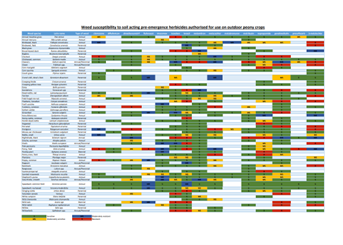Please click here to access the main AHDB website and other sectors.
- Home
- Knowledge library
- Weed control in outdoor peony crops for cut flower production
Weed control in outdoor peony crops for cut flower production
Introduction
Weed control in peony crops is challenging due to the long-term nature of the crop which can be 20+ years in production. The withdrawal of longer lasting effective herbicides such as Ronstar Liquid (oxadiazon) and Afalon (linuron) as previous building blocks of herbicide control programmes has left a significant gap in the grower armoury. The ever-reducing number of available herbicides and the lack of knowledge and investment in phytotoxicity testing for such a niche UK crop is posing a serious challenge to commercial growers in maintaining profitability and competitiveness against peony imports.
Perennial weeds such as creeping thistle (Circium arvense), docks (Rumex spp.), couch grass (Elytrigia repens), horsetail (Equisetum arvense), and others as well as some difficult to control annual weeds such as fat hen (Chenopodium album), black grass (Alopecurus myosuroides), cleavers (Galium aparine) and others cause serious problems mainly through competition for nutrients and water resulting in reduced crop vigour and number of marketable stems.
As with all ornamental crops, peony cut stems are marketed for their cosmetic appearance and therefore there is zero tolerance to any leaf, flower bud and petal or stem quality issues in the finished product. Commercial peony crops therefore have minimal tolerance to any herbicides which can potentially cause phytotoxic side effects.
Peony specific weed challenges
Peony crops are planted between late September and early December once soil conditions are suitable, moist, and still warm, depending on the autumn rainfall and ability to work the planting ground. Traditional planting densities have been higher (25,000 - 30,000 plants/ha) than those used recently in the UK (15,000 - 20,000 plants/ha). The planting material is usually imported from the Netherlands and there is a variation in planting material size. The 3/5 eye rootstock is the preferred choice for a shorter time to first commercial cropping, but some growers have opted for 2/3 eye rootstocks, particularly for higher cost unusual and premium varieties. It normally takes 3-4 years from planting to first commercial cropping. It is critical for the success of the crop overall to achieve successful weed control during these initial years of establishment when the vigour of weeds can most readily compete with peony plants as they are getting established. This is especially important during the first year of growth and for the 2/3 eye rootstocks. To put this into context, the planting material alone of a commercial peony planting is around £20,000 – £30,000/ha. The anticipated revenue from the fifth year onwards is around £45,000/ha and therefore any loss in marketable yield will have a significant impact on the return on investment.
Soil type should be considered when devising herbicide programmes and planning long term weed control. Most UK peony crops are planted on medium to heavy soils (sandy clay loam, clay loam, silty clay loam, sandy clay) by a small number of large growers (>20ha+) and several smaller growers (<20ha). A small proportion of UK peony production is planted on lighter soils. The main UK peony crops are grown in Lincolnshire, Cambridgeshire, Norfolk, Bedfordshire, Hertfordshire, Cornwall, with a small proportion grown in Northern Ireland and Scotland. As these areas coincide with much of the most productive UK arable land, the anticipated weed range is very similar to arable annual type of weeds, however the key challenge remains with the presence and control of perennial weeds.
It is recommended to plant peony rootstocks on raised ridges on heavy soil types and on flat beds for lighter soils. Most common planting schemes will range between 40-60cm in the row and 90-180cm between the rows providing density of 1.5-2.0 plants per m2. Tractor wheeling’s and servicing roadways are left based on the spraying and picking equipment utilised by the growers according to the field shape and size. Double row planting schemes are not common and mainly practiced on smaller holdings.
Planning a peony crop for first 3 years of growth
The low planting densities result in a significant surface area of exposed soil which is very quickly colonised by weeds and weed seeds. Planning the weed control strategy before planting is important as soil cultivations tend to bring the seedbank up to the surface from which both annual and perennial seeds can quickly germinate in the year of planting. It is important to control any weeds on stubble land in preparation for planting prior to ploughing and/or subsoiling using a mixture of non-selective and selective total weed control products such as Kyleo (2,4-D + glyphosate). It is not recommended for growers to use Farmyard Manure (FYM) as often which itself carries weed seeds adding to the weed pressure. Once land is prepared adopting a stale seedbed technique and controlling the weeds nearer the planting time is advisable. Depending on the size of fields and weather conditions, planting can take a considerably long time in some years and often by the time the crops are planted there are already numerous weed seedlings which can pose serious threat to the crops the following year if left uncontrolled.
Whilst there is little formal guidance on planting depth in the literature, it is clear that this will have an impact on successful crop establishment and also weed management. The risk from planting too shallow is that soon after frozen soil conditions peony roots can push out the tubers which exposes the peony crown and roots resulting in poor establishment and risk of damage from pre-emergence soil acting herbicides. Planting too deep risks delaying or even abortion of flowering. If the establishment of the crop is compromised in any way, this often leads to higher weed pressure as the crop canopy the following growing season helps with supressing weed establishment.
Pre-emergence soil acting herbicides should be applied soon after planting (October/November) to generate a herbicide layer and stop weed seed germination after planting. For any weed seeds that have started to germinate, it is recommended to use Shark (carfentrazone-ethyl) while the weed seedlings are within 2-4TL stage. Shark will provide some control of weed seeds closer to the soil surface, which is beneficial, however care must be taken to avoid overdosing or applying higher volumes of water per hectare particularly on shallow planted crops and crops on lighter sandy soils to avoid any risk of contact with the emerging peony crop.
In January a full-scale pre-emergence herbicide programme should be established whilst the peony crops are still dormant. Once shoot growth has started and the new shoots are above ground, careful consideration of herbicide choice and dose rate is required as to avoid significant phytotoxicity in first year. A standard herbicide programme will have 2 or 3 applications of pre-emergence herbicide mixtures up to the middle of March and early April with last application being usually at a lower rate than the maximum approved rate. The herbicides used will depend on the soil types and the weed spectrum of the field and previous cropping, so it is important to obtain good cropping history for each field where new peony crops are planted.
Once the peony shoots begin extensive growth stage herbicide applications stop and in the first 3 years growers are advised to switch to mechanical hoeing and physical removal of large canopy weeds such as fat hen, black nightshade, common orache and others before the weeds flower and seed to avoid accumulating a seed bank. On an average in the first two years from planting, mechanical weeding and hoeing could cost up to £600-£800/ha each time, however it is crucial this is carried at least twice in the spring and summer. Alongside mechanical weeding service roads and headlands should be kept weed free and where the inter-row space is wider, contact herbicide treatments can be applied using hooded/guard sprayers to protect the crop.
Where pernicious perennial weeds such as creeping thistle, creeping yellow cress, docks, giant hogweeds, perennial clover, couch grass etc are present it is advisable spot treat these with selective or non-selective contact total herbicides carefully around peony plants whilst avoiding drift from the hotspot weed areas. For peony plantations where inter-row space is over 120cm it is recommended to use a cover crop of perennial broadleaf and grass species to supress the weed and reduce possible seedbank.
Weed species and herbicides for peony crops
The tables below provide the detail needed for developing an effective weed management strategy for peony crops. They include information on common weed species and their susceptibility to herbicides, and on tolerances of peony crops to herbicides at different stages of the crop. The information to produce the below tables is derived from Health and safety executive plant protection database, product labels, manufacturers literature, AHDB weed control projects PO/BOF 002a, PO/BOF 002b, BOF 051a, BOF 051,HNS/PO 192 HNS/PO 192a and CP 086, as well as USDA IR4 programme 2011, American Peony Society, NC State University and peony growers from Holland.
Table 1 provides detailed information on approved herbicides for outdoor peony crops highlighting the range of herbicides available to UK growers with various modes of action, type of herbicides and any specific approval details in relation to peony crop production.
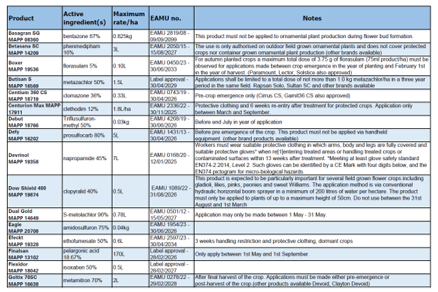
Click here to see the full table
Table 2 covers the susceptibilities of common weed species to soil acting pre-emergence herbicide active substances. Please note that efficacy of these herbicides will depend on the timing of application, soil conditions at time of application and coverage.
Click here to see the full table
Table 3 covers weed susceptibility to foliar-acting selective contact herbicides authorised for use on outdoor peony crops

Click here to see the full table
Table 4 covers weed susceptibility to foliar-acting non-selective contact herbicides authorised for use on outdoor peony crops
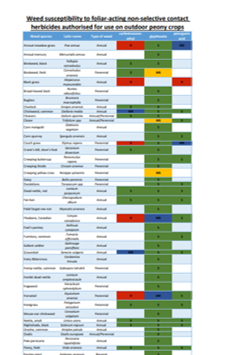
Click here to see the full table
Table 5 indicates peony crop tolerance to a range of herbicide types approved for use on ornamentals
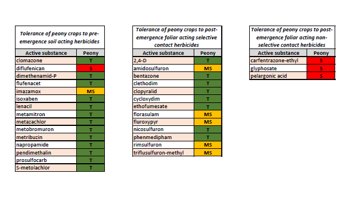
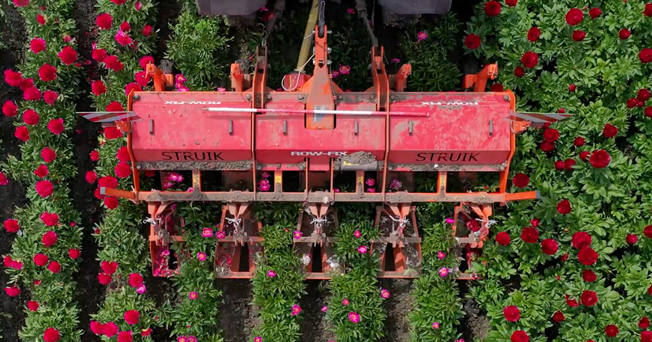 Struik Wieringermeer B.V.
Struik Wieringermeer B.V.
Experiences from Cut Flower Centre peony herbicide testing
Read the Peony herbicide trials summary covering 2019-2023 from the Cut Flower Centre project.
A summary of Cut Flower Centre led Peony herbicide trials
Example herbicide programmes for peony crops
Devising a herbicide programme for peony crops depends on several parameters. Find out more about which factors are important and how they inform herbicide selection.
Herbicide programmes for peony crops
Additional resources
Look through the index of cut flower resources for links to more content


